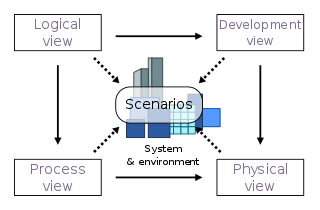
Software architecture refers to the fundamental structures of a software system and the discipline of creating such structures and systems. Each structure comprises software elements, relations among them, and properties of both elements and relations. The architecture of a software system is a metaphor, analogous to the architecture of a building. It functions as a blueprint for the system and the developing project, laying out the tasks necessary to be executed by the design teams.
ISO/IEC/IEEE 12207Systems and software engineering – Software life cycle processes is an international standard for software lifecycle processes. First introduced in 1995, it aims to be a primary standard that defines all the processes required for developing and maintaining software systems, including the outcomes and/or activities of each process.
Architecture description languages (ADLs) are used in several disciplines: system engineering, software engineering, and enterprise modelling and engineering.
The ISO/IEC 15288 is a technical standard in systems engineering which covers processes and lifecycle stages, developed by the International Organization for Standardization (ISO) and the International Electrotechnical Commission (IEC). Planning for the ISO/IEC 15288:2002(E) standard started in 1994 when the need for a common systems engineering process framework was recognized. The previously accepted standard MIL STD 499A (1974) was cancelled after a memo from the United States Secretary of Defense (SECDEF) prohibited the use of most U.S. Military Standards without a waiver. The first edition was issued on 1 November 2002. Stuart Arnold was the editor and Harold Lawson was the architect of the standard. In 2004 this standard was adopted by the Institute of Electrical and Electronics Engineers as IEEE 15288. ISO/IEC 15288 has been updated 1 February 2008 as well as on 15 May 2015.

An enterprise architecture framework defines how to create and use an enterprise architecture. An architecture framework provides principles and practices for creating and using the architecture description of a system. It structures architects' thinking by dividing the architecture description into domains, layers, or views, and offers models - typically matrices and diagrams - for documenting each view. This allows for making systemic design decisions on all the components of the system and making long-term decisions around new design requirements, sustainability, and support.
IEEE 1471 is a superseded IEEE standard for describing the architecture of a "software-intensive system", also known as software architecture.

4+1 is a view model used for "describing the architecture of software-intensive systems, based on the use of multiple, concurrent views". The views are used to describe the system from the viewpoint of different stakeholders, such as end-users, developers, system engineers, and project managers. The four views of the model are logical, development, process and physical view. In addition, selected use cases or scenarios are used to illustrate the architecture serving as the 'plus one' view. Hence, the model contains 4+1 views:
ISO/IEC/IEEE 42010Systems and software engineering — Architecture description is an international standard for architecture descriptions of systems and software.

A view model or viewpoints framework in systems engineering, software engineering, and enterprise engineering is a framework which defines a coherent set of views to be used in the construction of a system architecture, software architecture, or enterprise architecture. A view is a representation of a whole system from the perspective of a related set of concerns.

Open-system environment (OSE) reference model (RM) or OSE reference model (OSE/RM) is a 1990 reference model for enterprise architecture. It provides a framework for describing open system concepts and defining a lexicon of terms, that can be agreed upon generally by all interested parties.

TRAK is a general enterprise architecture framework aimed at systems engineers. It is based on MODAF 1.2.
ISO/IEC 29110: Systems and Software Life Cycle Profiles and Guidelines for Very Small Entities (VSEs) International Standards (IS) and Technical Reports (TR) are targeted at Very Small Entities (VSEs). A Very Small Entity (VSE) is an enterprise, an organization, a department or a project having up to 25 people. The ISO/IEC 29110 is a series of international standards and guides entitled "Systems and Software Engineering — Lifecycle Profiles for Very Small Entities (VSEs)". The standards and technical reports were developed by working group 24 (WG24) of sub-committee 7 (SC7) of Joint Technical Committee 1 (JTC1) of the International Organization for Standardization and the International Electrotechnical Commission.
DUALLy is an MDE framework to create interoperability among Architecture Description Languages (ADLs). It is developed at the Computer Science Department of the University of L'Aquila. DUALLy enables the transformation of a model conforming to a specific architecture description language into corresponding models conforming to other architecture description languages.
Software architecture description is the set of practices for expressing, communicating and analysing software architectures, and the result of applying such practices through a work product expressing a software architecture.
ISO/IEC JTC 1/SC 7 Software and systems engineering is a standardization subcommittee of the Joint Technical Committee ISO/IEC JTC 1 of the International Organization for Standardization (ISO) and the International Electrotechnical Commission (IEC), that develops and facilitates standards within the field of engineering of software products and systems. The international secretariat of ISO/IEC JTC 1/SC 7 is the Bureau of Indian Standards (BIS) located in India.
ISO/IEC/IEEE 29119Software and systems engineering -- Software testing is a series of five international standards for software testing. First developed in 2007 and released in 2013, the standard "defines vocabulary, processes, documentation, techniques, and a process assessment model for testing that can be used within any software development lifecycle."
In software engineering and software architecture design, architectural decisions are design decisions that address architecturally significant requirements; they are perceived as hard to make and/or costly to change.





